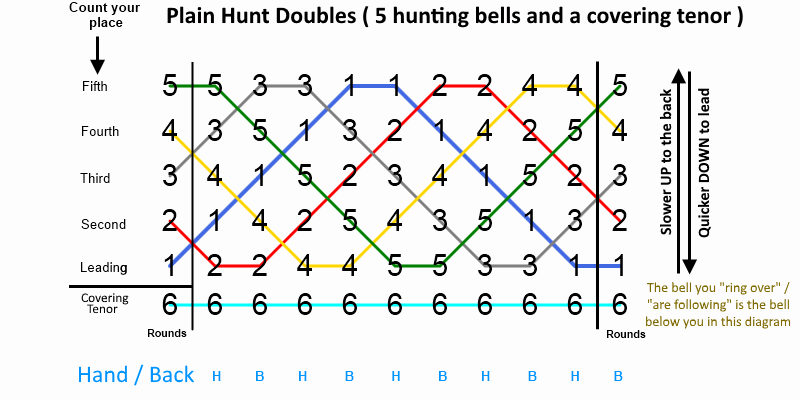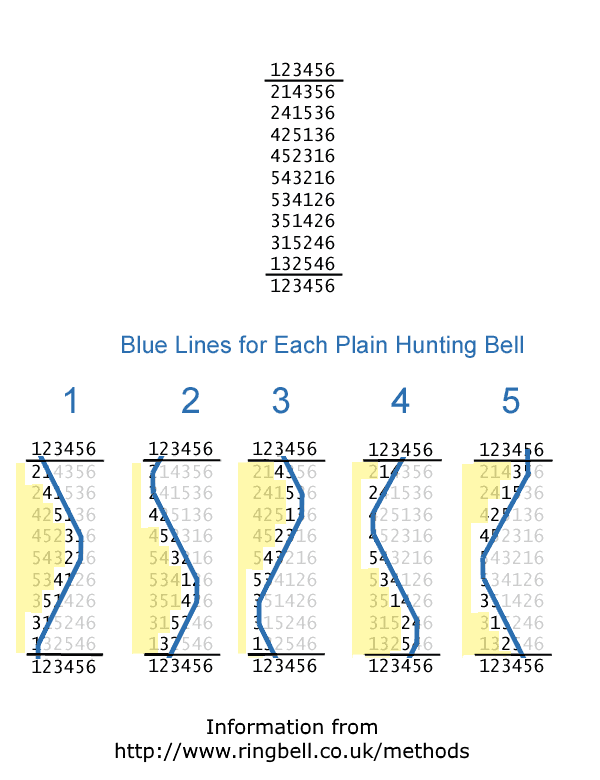Where do I start?
In the area above this text, the top diagram shows the rows of changes in plain hunt, starting from rounds and ending in rounds. The five drawings below it show the individual work of each bell, the bell moves places in accordance with the blue line and follows (rings after) the bell to the left that is coloured Black. The other bells are shaded over to enable you to focus on the bell you must follow. The columns represent the places, the left column is 'leading', then moving towards the right, the next column is '2nds Place', then '3rd Place' etcetera. The No.6 (Tenor) bell remains in the right-hand column, covering in 6th Place. Notice that bells 1 to 5 all do the same shaped Blue line but start from different places upon it.
Most people start to learn Plain Hunt by remembering the bells they ring after. It must be stressed that as soon as possible, you should start counting places, as this is essential when you move on to more complicated things. The places are important as they give an indication of the speed to ring at. When counting UP, you will have to ring slower than in rounds. When counting DOWN, you must ring quicker in order to be able to follow the correct bell. For a detailed explanation of what is meant by quicker or slower visit the
Ringing Speed page.
The table below represents the same thing as the diagrams but in text. It may help you if you colour in the bell you are learning with a highlighter pen - On paper not the screen! Don't just learn one bell, there may be occasions when there is more than one learner present, which will be no good if everyone wants to ring the same bell.
The Work of all Bells in Plain Hunt Doubles
Change ⇒
Handstroke / Backstroke ⇒ |
R
o
u
n
d
s |
1st
H |
2nd
B |
3rd
H |
4th
B |
5th
H |
6th
B |
7th
H |
8th
B |
9th
H |
R
o
u
n
d
s |
| |
| Treble Counts Places | | 2 | 3 | 4 | 5 | 5 | 4 | 3 | 2 | L | L |
| Treble Rings after | 6 | 2 | 4 | 5 | 3 | 2 | 4 | 5 | 3 | 6 | 6 |
| |
| Second Counts Places | | L | L | 2 | 3 | 4 | 5 | 5 | 4 | 3 | 2 |
| Second Rings after | 1 | 6 | 6 | 4 | 5 | 3 | 1 | 4 | 5 | 3 | 1 |
| |
| Third Counts Places | | 4 | 5 | 5 | 4 | 3 | 2 | L | L | 2 | 3 |
| Third Rings after | 2 | 4 | 5 | 1 | 2 | 4 | 5 | 6 | 6 | 1 | 2 |
| |
| Fourth Counts Places | | 3 | 2 | L | L | 2 | 3 | 4 | 5 | 5 | 4 |
| Fourth Rings after | 3 | 1 | 2 | 6 | 6 | 5 | 3 | 1 | 2 | 5 | 3 |
| |
| Fifth Counts Places | | 5 | 4 | 3 | 2 | L | L | 2 | 3 | 4 | 5 |
| Fifth Rings after | 4 | 3 | 1 | 2 | 4 | 6 | 6 | 3 | 1 | 2 | 4 |
| |
| Tenor is always last in 6th Place | | 6 | 6 | 6 | 6 | 6 | 6 | 6 | 6 | 6 | 6 |
| The Tenor Rings after | 5 | 5 | 3 | 3 | 1 | 1 | 2 | 2 | 4 | 4 | 5 |
The Staircase or Rollercoaster Approach
Here is another way of looking at Plain Hunt, the conventional diagram is turned on it side, so you work your way from left to right. Your tutor may say phrases like, 'Slowly up to the back' or 'Quicker down to the lead' when referring to the speed that you need to ring when hunting. This diagram assists that way of thinking, imagine you are on a staircase, you walk slowly up and quicker down the stairs.
Tutors often use the expressions 'Follow the XXX' or 'Ring Over the XXX' which means 'Ring after bell XXX'. In this style of diagram, the bell you ring over, is the one under you on the diagram, which makes more sense.

Taking bell four for example: In rounds it is ringing after the three. When the conductor calls go: at the next handstroke, it needs to ring slightly quicker than when ringing rounds, it will ring over the treble and count thirds place. At the back stroke it moves down to second place, ringing over the two. At handstroke, it leads and the same at backstroke too. The line is horizontal, indicating it must ring at rounds speed, leading off the tenor bell. At the next handstroke it moves up to second place, the line is going up, so it must ring slower than when in rounds, then it will be in the right position to ring over bell five.
It is important to learn plain hunt, or any other method before taking hold of a rope. Its not practical to try to read a diagram or look at a list while actually ringing, as your eyes need to be looking at the other bells. We all have different ways of remembering the pattern of our bell. Here are three different ways of presenting the same information, hopefully you will find one way that suits you. No matter how good the information may be on a website it cannot be a substitute for talking it over with your tutor or other ringers.

